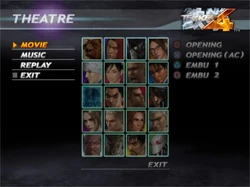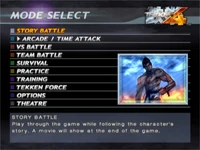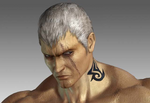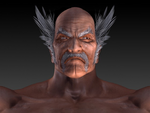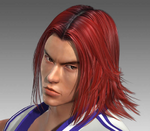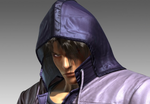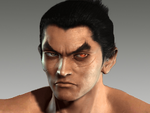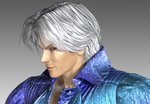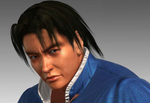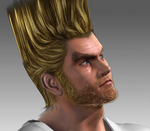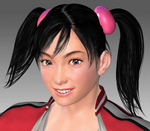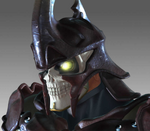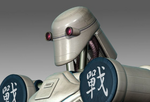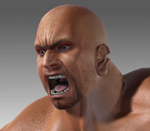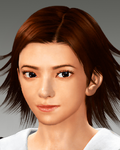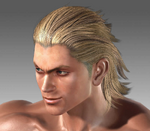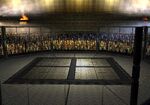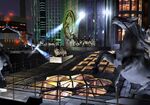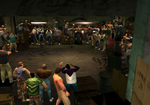Tekken 4 (鉄拳4 Tekken Fō?, lit. Iron Fist 4) is the fourth main installment in the Tekken video game franchise, and the second game in the Tekken series (first in the main series) released for the PlayStation 2. Developed and published by Namco, it was released as an arcade game in 2001 and on the PlayStation 2 in 2002, with the tagline A New Century of Fighting. The game introduced significantly altered gameplay and mechanics compared to its predecessors; these experimental changes divided opinion amongst fans and critics. It was, however, praised for highly realistic graphics and visuals for its time, as well as its cinematic endings. Tekken 4 is notably the first canon game where the three major series protagonists, Heihachi Mishima, Kazuya Mishima, and Jin Kazama, appear together. It was followed by Tekken 5 and the standalone update to Tekken 5; Tekken 5: Dark Resurrection.
Story[]
After The King of Iron Fist Tournament 3, Heihachi failed to apprehend Ogre. Determined not to fail, Heihachi had his researchers gather Ogre’s skin tissue, hoof fragments, and blood samples for genetic experiments. Unfortunately, Heihachi’s goal of creating a new life form by splicing Ogre’s genome with his own was unsuccessful.
Heihachi learned, after extensive experimentation, that the Devil Gene was needed to successfully splice Ogre’s genetic code into another living organism. Unfortunately, Heihaci’s own genome lacked the Devil Gene. However, there was someone who had the gene, Jin Kazama.
Jin was shot and mortally wounded by Heihachi after defeating Ogre in The King of Iron Fist Tournament 3. As his life slipped away, Jin transformed into a devil and mysteriously vanished.
Although his quest to find Jin became futile, Heihachi did discover a 20-year-old photograph that stirred his curiosity. The photograph had an image of a burnt corpse riddled with laceration wounds and deformed, protruding, wing-like limbs.
Heihachi was convinced it was a picture of his son, Kazuya, whom he hurled into the volcano 20 years ago. With all of his resources redirected into finding the body, the search ultimately led to a biotech firm called G Corporation, a company known for making unparalleled developments in the area of biogenetics research. G Corporation found Kazuya’s body and began conducting research on his genetic data to examine the true nature of the devil that existed within him. Heihachi also found out that Kazuya’s remains and research data were stored at G Corporation’s Nebraska and Nepal research facilities, respectively.
Unbeknownst to Heihachi, Kazuya was resurrected by G Corporation and had an agenda of his own. Kazuya’s aspiration was to fuse his two selves into one so that he could truly utilize the power of the Devil Gene and seek vengeance against Heihachi and the Mishima Zaibatsu.
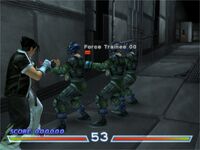
Tekken 4 Tekken Force mode with Jin Kazama.
On a chilly Christmas night, Heihachi decided to send his Tekken Force to infiltrate the research labs in hopes of recovering both the research data and Kazuya’s remains. The assault on the Nepal lab went smoothly, whereas the infiltration of the Nebraska facility did not go according to plan. From the helicopter, Heihachi noticed on the tactical status monitor screen that his troops met some sort of resistance. As the figure responsible for this emerged from the shadows, Heihachi was shocked to find out that it was his own son, Kazuya.
With Heihachi ruining his plans of unification, Kazuya disappeared into the facility’s ruins after taking his anger out on Heihachi’s pitiful soldiers.
With Kazuya back in the picture, Dr. Abel, Heihachi’s lead scientific advisor, compelled him to figure out a way to capture Kazuya immediately. With a malicious smile, Heihachi devised a way to accomplish this.
Two years have now passed since The King of Iron Fist Tournament 3. The Mishima Zaibatsu has announced The King of Iron Fist Tournament 4, with the grand prize being the sole ownership of the Mishima Zaibatsu. Kazuya enters the tournament knowing that it’s merely a trap to draw him out of hiding. To Kazuya, the prize means less than his pursuit of revenge against his father, Heihachi.[1]
After defeating many opponents, Kazuya arrives at Stage 7 for a match against his son, Jin Kazama. Having trained in traditional karate during the two years between the tournaments, Jin entered the The King of Iron Fist Tournament 4 to destroy the Zaibatsu and put an end to the cursed Mishima bloodline; however, he is captured by Tekken Force on the way to his match with Kazuya and taken to Hon-Maru. Faced with no opponent, Kazuya is reported as the default winner of their match. Sensing Heihachi's interference in Jin's disappearance, Kazuya proceeds to the final stage.[2]
There, Kazuya meets Heihachi and he asks what he has done to Jin. Heihachi says that he will tell him after their fight. Kazuya loses to Heihachi and is taken by him to Hon-Maru.[3] Jin is suspended between two pillars by chains wound around his forearms. As Kazuya sees his son for the first time, Devil suddenly takes over. "So, you were with him after all, my half..." Heihachi realizes Kazuya is not himself, and asks, "Who are you?!" with Devil replying, "I am what you refer to as 'Devil.' Twenty years ago, I lost a part of myself when you nearly killed me. Now, I'll retrieve what's rightfully mine from him! The time has come for my resurrection!"
Devil goes on: "You saved me the trouble of having to search for him. For your troubles, I'll give you a taste of my power!" He uses a telekinetic ability to knock Heihachi out of the room, and tries to draw Jin's devil out of him to reclaim it. Devil is unable to trigger Jin's full devil transformation, and speculates whether it is because of Jin's 'Kazama blood'. With some effort, Kazuya wrests back control of himself and, implying that he has successfully 'fused his two selves', says, "I see... Didn't know about this method of unifying our power." He calls for Jin to rise.
Jin stirs, and frees himself from the chains. He seethes, "You! If only you were dead... Once I kill you, it'll all be over!" Jin and Kazuya fight, with Jin emerging as the victor.
Heihachi reemerges and mocks Kazuya's prone form: "What a pathetic wretch... You worthless coward." He challenges Jin with the intention of killing him and taking his Devil Gene for himself. However, Heihachi is also defeated by Jin.
Jin holds Heihachi up by his gi, and the wings of Jin's Devil form emerge as he prepares to deliver the killing blow. However, before the strike can make contact, a bright light distracts Jin, and he turns to see a brief vision of his mother, Jun Kazama. Struck with emotion and clarity of mind, he lets Heihachi go. "Thank my mother... Jun Kazama," he tells Heihachi, before walking away and taking flight through Hon Maru's roof. Several feathers drift to the floor, one of which is white rather than black.[4]
Gameplay[]
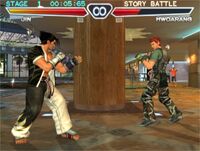
Jin Kazama versus Hwoarang.
Tekken 4 introduced significant new gameplay changes from the previous games in the series. For the first time, it allowed players to maneuver around an arena interacting with walls, pillars, and Ceilings for extra damage. These "environmental hazards" in turn allowed players to juggle opponents for consecutive combos and allowed the designers to implement a "switch maneuver", which let players escape from cornering and throw the tide in their favor. Also, the game engine had been tweaked to be more focused on the environment, causing the characters to move more slowly and fluidly than in Tekken Tag Tournament and Tekken 3. Finally, the game introduced a brand new graphics system, that featured increased lighting, dynamic physics, and smoother surfaces. The music in Tekken 4 is also different from Tekken 3, toning down the energy for a calmer and a more diverse soundtrack.
Tekken 4 heavily toned down combos as a result; arguably having them at the weakest in the series. The Sidestep was also nerfed to cover much less distance in comparison to previous games, but the game also introduced the mechanic of side walking to allow continuous movement to the sides. Notably, sidestepping and side walking were moved to the command of u or b. Jumping could only be done forward unlike all other installments, while it was no longer possible to move backwards while crouching; something that would actually remain in succeeding games.
In high-level tournament play, it became apparent that the engine changes caused the game to heavily favor quick jabs and punches, upsetting some fans due to the decline in usefulness of more complex moves and strategies. This also came at a time when jabs were not at a universal speed, with characters like Steve Fox having an easy advantage due to his jab being faster than most of the others. Jin Kazama especially was very overpowered, and if one were to look at the tournament records, he was used by nearly every top player. In terms of technicals, the PlayStation 2 version of Tekken 4 was also the first in the series to be playable in higher quality progressive scan display mode (including the PAL version), noticeably a feature absent from its successor Tekken 5. The PAL version is also playable at 60 Hz.
Tekken Force (Mode)[]
Tekken 4 includes a beat em' up mini-game available from the outset called Tekken Force. A successor to the mini-game found in Tekken 3, it presents the player with an over-the-shoulder (or 3rd-person) perspective as they fight wave upon wave of Heihachi Mishima's Tekken Force soldiers through four stages, eventually facing Heihachi himself. The player can pick up health and power-ups while they fight waves of enemies. In the mini-game, it is discovered that the Tekken Force soldiers possesses different ranks in the organization, evident in different amounts of stamina, strength, and skill.
Moves[]
List of moves by character that can be performed in Tekken 4.
See: Tekken Move 4 Lists
Characters[]
Returning characters[]
(unlockable)
(bonus unlockable, console exclusive, costume swap of Christie)
(main final boss, unlockable)
(unlockable)
(unlockable)
(unlockable)
(unlockable)
(unlockable)
(unlockable)
(unlockable, costume swap of Kuma)
New characters[]
(unlockable)
(bonus unlockable, console exclusive, costume swap of Xiaoyu)
(unlockable, Lee in disguise, costume swap of Lee)
Cameos[]
- Armor King I - in Marduk's prologue
- Devil Kazuya - in Kazuya's ending
- Doctor Bosconovitch - in Bryan's ending
- Jun Kazama - in Jin's ending
Unlockable characters[]
| Character | Condition to unlock |
|---|---|
| Jin Kazama | Beating Story Mode one time with a character. |
| Violet | Beating Story Mode two times with a different character. Violet becomes a costume swap for Lee when he is unlocked. |
| Nina Williams | Beating Story Mode three times with a different character or beating the mode with Steve Fox. |
| Lei Wulong | Beating Story Mode four times with a different character. |
| Bryan Fury | Beating Story Mode five times with a different character or beating the mode with Yoshimitsu. |
| Julia Chang | Beating Story Mode six times with a different character. |
| Kuma II / Panda | Beating Story Mode seven times with a different character or beating the mode with Ling Xiaoyu. |
| Heihachi Mishima | Beating Story Mode eight times with a different character. |
| Lee Chaolan | Beating Story Mode eight times with a different character or beating the mode with Violet. |
| Combot | Beating Story Mode nine times with a different character or beating the mode with Violet. |
| Eddy Gordo | Beating Story Mode with Christie Monteiro. |
| Miharu Hirano | Beating Story Mode with Ling Xiaoyu. |
Stages[]
Music[]
The Tekken 4 Original Soundtrack was released May 22, 2002, containing music from the console version.
Gallery[]
- Main article: Tekken 4/Gallery
Videos[]
Controversy[]
While relatively popular in its day, it is often considered by fans to be the worst main-series Tekken game, due to the omission of many popular characters and the introduction of major balance issues and bugs that impaired competitive play. It is also considered the most experimental Tekken game, featuring several game-changing new mechanics that never returned in later iterations.
Trivia[]
- This Tekken game is notable for having these distinctions:
- It is the first game to feature voice-acted dialogue for all characters, and it is also the only game where, when a character speaks before and after a fight, subtitles are not displayed. Additionally, Hwoarang spoke Korean only in English versions of the game (he had Japanese and English voice lines in the Japanese release).
- It is the only game in the series where characters can move freely at the beginning of a match, before the announcer has given the go-ahead to start fighting. It is also the only game lacking backward and vertical jumps, though forward jumps remain.
- It is the only game featuring elevation variation on the floors of certain stages (slight dips and inclines, for example).
- It is the only mainline game that does not feature a Jack robot participant (though Jack-4 robots exist outside of the tournament). Additionally, it is the only game not to feature Anna Williams.
- This is the first arcade game wherein a KO'd character who falls forward to the ground will raise their torso and clutch their midsection as though in pain before lying prone, a feature first introduced in the PlayStation 2 version of Tekken Tag Tournament.
- This is the only game featuring Christie in a default outfit wherein her hair is not tied back.
- It is the only game in which Paul Phoenix has relaxed hair in one of his default outfits.
- It is the first game wherein there is replay save functionality.
- It is the only game so far where the final boss battle takes place in a a walled stage rather than an infinite stage (although the final boss battle in Tekken 7 takes place in Devil's Pit, which transitions from walled to infinite).
- It is the last game where every stage is set in a grounded, realistic location. The overall location of the tournament itself is theorized to be Tokyo, Japan, as there is one stage that takes place in Tokyo's Shinjuku district.
- It is the last game where all the stages feature floors that do not crack or otherwise sustain damage if a character falls to the ground. In later games, the floor of most stages sustain visual damage when a character falls.
- It is the first and only game to not have yellow or turquoise-colored life meters in any of its iterations. The vanilla version of Tekken Tag Tournament 2 used turquoise life meters before switching to blue in Unlimited.
- It is the first of two games in the series where Jin Kazama is not seen wearing his trademark studded gauntlets. Instead, he wears a set of arm guards detailed with the Kazama Clan crest. This carries over into Tekken 5, where he retains element of both his costumes from the this game in some capacity.
- This is the first time that Eddy Gordo, Jin Kazama, Lei Wulong, and Nina Williams are unlockable characters in the series.
- It is the first game in the series where the console version's intro is extended from the arcade version. In Tekken 4's case, the arcade version shows the Tekken Force's raid on G Corporation's Nebraska facility;[5] the console version uses this footage too, but intersperses it with a few short clips showcasing the game's new characters (Steve Fox, Craig Marduk, and Christie Monteiro).[6]
- It is the first game where middle-range attacks in Practice Mode are labeled as 'Middle' instead of 'Mid'.
- Unlike in Tekken 3, a character only performs their win pose after the match, rather than after each round. New to this game are animations of defeated characters rising from their knockouts at the end of each round to continue fighting. Text at the end of each match ('You win', 'You lose', etc.) now appears in the center of the screen rather than at the bottom of it.
- This is the first game where the "Perfect" match win text has the exclamation point omitted. The word 'Fight!' is now shown at the start of the match, and when a fighter wins a round with a maximum of 5% health left, the word 'Great' is now shown.
- During a win replay, the text reading 'Replay' is now at the bottom and flashes on the loser's side. If the match ends with a double KO, the word flashes on the left side.
- On the vs. screen before each fight, the phrase 'Get ready for the next battle!' is shown.
- It is the last Tekken game where the countdown on the 'Continue' screen is to the right of the word 'Continue?'.
- It is the only Tekken game on the PlayStation 2 that supports progressive scan (480p) display output.
- It is the first game to feature win animations that show the winning character interacting with a downed opponent (in this game, Bryan Fury, Heihachi Mishima, Hwoarang and Kazuya Mishima are the only characters that have this kind of win animation).
- It is the first game where ambient noises from a stage can be heard when the game is paused, and where the characters' models disappear when the game is paused. The latter would happen again in the PSP version of Tekken 5: Dark Resurrection.
- It is the first and only game where there are no infinite stages.
- It is the first game where stages can be picked in Practice and VS modes.
- Tekken 4 appeared on a 2003 Namco sampler disc called Namco Transmission.[7] The sampler disc came packed in with some PlayStation 2 copies of Soulcalibur III. Tekken 4 is not playable on the disc; rather, the sampler allows players to download Tekken 4 save data with all characters unlocked.
- A demo disc was packed in with certain PlayStation 2 systems, and featured demos and trailers of several PlayStation 2 games that were available or upcoming at the time. Tekken 4 was present on this demo disc. The demo allowed players to pick from two characters, Christie Monteiro and Paul Phoenix, and play four matches.[8]
- The aforementioned demo was also available on a demo disc that came with PlayStation 2 systems. The disc
- Theater Mode is available after beating the game once.
- In Heihachi's Tekken 2 ending, Kazuya is wearing his purple tuxedo as Heihachi drops him into the volcano.[9] However, in the depiction of this event in Tekken 4's opening, Kazuya is wearing his white karate pants instead.
- The arcade version has a number of unused voice clips from the announcer.[10]
- Among these, there are name call-outs for characters from Tekken Tag Tournament that were not in Tekken 4, specifically Anna Williams, Jun Kazama, Forest Law, Ganryu, Gun Jack, Armor King, Michelle Chang, Baek Doo San, Jack-2, Bruce Irvin, Kunimitsu, Tetsujin, Mokujin, Wang Jinrei, Prototype Jack, Devil, Angel, Ogre, True Ogre, Roger, Alex, Tiger Jackson, Doctor Bosconovitch, and Unknown. All of these are placeholder leftovers.
- Other voice clips include what are likely early names for Steve (Dean Earwicker, Leonard Gardner, Ryan Lewis, Sugar McGregor), Christie (Amy Nascimento, Fiona Gilberto) and Violet (Benjamin).
- There is a clip for Kinjin, who at the time was not a proper character, but an unused name for Tetsujin's gold palette swap in Tekken Tag Tournament. There is also a voice clip for Enjin, which could imply that a new Mokujin variant (likely a mechanical one, as 'enjin' is Japanese for engine) was to be introduced.
- The announcer says Jinpachi Mishima's name even though this character would not be introduced until the next game, Tekken 5, as the final boss.
- Koguma (小熊, lit. 'a cub' or 'small bear/kuma') and Kopanda (小パンダ, lit. 'small panda') are mentioned, but the purpose of these names is unknown. A theory is that they would have been used in the Tekken Force mode (like the small bear enemies present in some stages of Tekken 6's Scenario Campaign). If they had been present, they likely would have been in Tekken Force Stage 2 (Temple Ruins) (Kuma's Stage/Panda's Stage).
- Lastly, Doctor Abel, the Tekken Force, and Grandmaster are mentioned.
- There was an unreleased mode called Boost Mode that acted as a turbo mode of sorts. It increased the movement speed of characters and also decreased the recovery time of attacks. It is unknown why this mode was removed. Boost Mode's code is still present within the game and can be accessed through hacking.
See Also[]
External Links[]
References[]
- ^ Tekken 4: Prima's Official Strategy Guide, p2.
- ^ Tekken 4: Jin Prologue and Epilogue, YouTube
- ^ According to Kazuya's Tekken 5 profile, he lost the battle to Heihachi, meaning the canonical ending for Tekken 4 is the first part of Heihachi's ending, then part of Kazuya's ending, then Jin's ending. See King of Iron Fist Tournament winners and Kazuya's TK5 profile: http://www.tekkenzaibatsu.com/tekken5/profile.php?id=kazuya
- ^ Tekken 4 - Jin and Kazuya Ending Combined, YouTube
- ^ Tekken 4 (Arcade Edition) - CGI Opening Intro - HD, YouTube
- ^ TEKKEN 4 Intro, YouTube
- ^ PS2 - Namco Transmission Menus + Bonuses, YouTube
- ^ TEKKEN 4 PlayStation 2 Demo Disc gameplay, YouTube
- ^ Tekken 2: Heihachi Mishima - A Son's Fall, YouTube
- ^ Tekken 4 - Announcer Voice Samples (Namco System 246), YouTube

